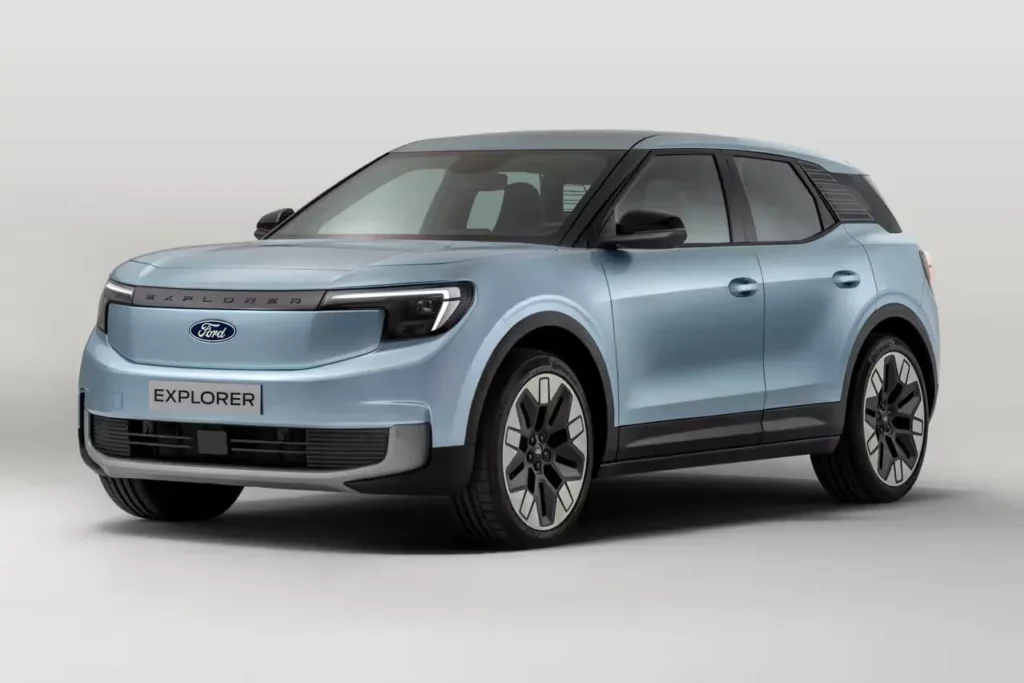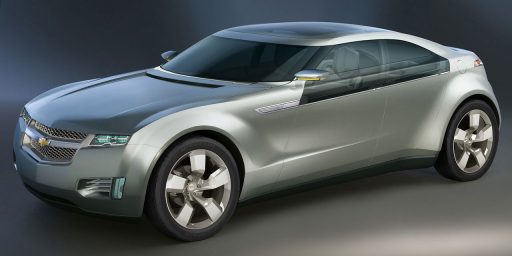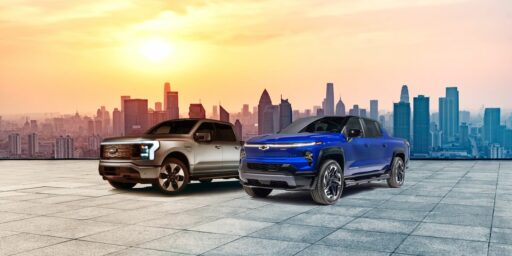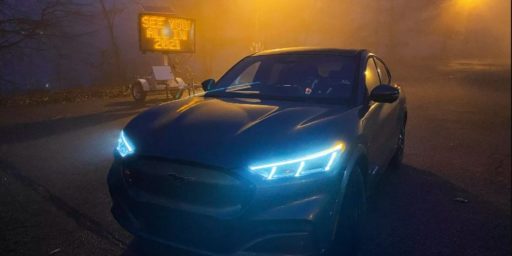Ford Doubling Down on EVs, But Not in USA
The company will debut an all-electric "Explorer" in Europe.

Barron’s (“Ford Is Electrifying Its Most Iconic SUV”):
First came the Mustang. Then the F-150 pickup truck. Now the Ford Explorer is going electric.
Ford Motor F –1.06% (ticker: F) on Tuesday unveiled its all-new, all-electric 2023 Ford Explorer for the European market.
The iconic SUV made its debut in 1990 and is the company’s best-selling model after the F-150 pickup truck.
You know you’re getting old when products introduced within your adult lifetime have become “iconic.”
Ford sold 207,673 Explorers in the U.S. in 2022, down from 219,871 sold in 2021. (Ford sold 653,957 F-series trucks in the U.S. in 2022).
U.S. buyers will have to wait though since the electric version of the Explorer is only for Europe right now. The five-seat, crossover-sized vehicle will be built in Germany. Range and power details weren’t included in Ford’s news release, but Ford said the battery can be charged from 10% to 80% in about 25 minutes using high speed, direct current EV chargers.
That’s fast enough to be reasonable for those who want an EV but can’t afford or are otherwise unable to get a home charger for overnight charging.
By next year, Ford estimates there will be 500,000 charging points across Europe. There are roughly 148,000 public charging ports in the U.S., according to the Energy Department. America has been adding roughly 20,000 ports a year for the past few years.
Granting that Europe collectively is larger, richer, and more densely populated than the United States, the gap is telling. And we’re adding ports at a rate where we’ll never catch up. (There was some investment in new charging infrastructure in the so-called Inflation Reduction Act but it’s certainly not going to get us to European standards.) That’s a problem considering that consumers and manufacturers alike are pushing full steam ahead on moving to EVs; indeed, California is mandating it.
The electric Explorer adds to Ford’s EV lineup, which includes the Mustang Mach E, F-150 Lightning and electric Transit van. In 2022, Ford sold more than 61,000 all-electric vehicles in the U.S., up about 125% year over year.
Key to that growth was an expanding lineup. Ford began selling the F-150 Lightning and electric Transit van in 2022.
Ford has plans to sell many more EVs in coming years. “We’re on track for a run rate of over 600,000 EVs by the end of this year and 2 million by late 2026,” said Bob Holycross, Ford’s vice president of sustainability, environment and safety Engineering, at a Deutsche Bank investment conference in March. “The customer response to these vehicles has just been incredible.”
Overall, I welcome the move. It makes sense that Ford is finally making its most popular vehicles available with electric options rather than making weird models few want to buy. Sort of.
Autoblog (“European-spec 2023 Ford Explorer is an EV with Volkswagen bones“) explains:
Ford enlisted the help of Volkswagen and repurposed a familiar nameplate to plant its stake in Europe’s electric crossover segment. Built on the MEB platform, the European-market Explorer is an electric, city-friendly model that shares nothing but a name with the SUV sold here.
Let’s address the elephant in the room: the model pictured in our gallery is not a replacement for the American-market Explorer, and Ford confirmed to Autoblog that it will not be sold in the United States. “The new electric Explorer is the European interpretation of an electric Explorer — made in Europe for Europe,” a spokesperson told us. That’s not a “maybe,” a “we’ll see,” or a “who knows?” It’s a “no.”
Visually, the Explorer’s front end is characterized by a grille-less design and an “EXPLORER”-branded piece of trim flanked by thin lights. It rides on a relatively long wheelbase, while its rear bumper features a piece of trim shaped like the one embedded into the front bumper. Full technical specifications haven’t been released but Ford notes the crossover stretches roughly 177 inches from bumper to bumper. In comparison, the American-market Explorer (which is available in some European nations) measures approximately 199 inches long.
Step inside and you’ll find space for five passengers on two rows of seats. The driver faces a digital instrument cluster, while the dashboard is dominated by a height-adjustable, 15-inch touchscreen that displays the infotainment system and hides a storage compartment. Ford also included some cool features, such as a massive center console capable of holding a 15-inch laptop and a futuristic-looking sound bar positioned on top of the dashboard. Numerous electronic driving aids, including Assisted Lane Change, will be offered as well.
[…]
Wrapping your head around the idea of two decades-old rivals joining forces to design a car might require Olympic-level mental gymnastics, but this isn’t the first time Ford and Volkswagen have teamed up. The second-generation Amarok truck introduced in 2022 is closely related to the newest version of the Ranger under the sheet metal. There’s plenty more: set your time machine to 1991, board a 747 to Brazil, walk into a Ford showroom, and you’ll spot a sedan called Versailles that was a badge-engineered Santana that emerged from a Volkswagen-Ford joint-venture called AutoLatina. Its wagon sibling was marketed as the Royale. The collaboration went both ways: Volkswagen’s Pointer and Logus models were badge-engineered variants of the Escort and Orion, respectively. The joint-venture was dissolved in 1995.
HypeBeast (“Ford Expands Its European Market With the All-New Explorer EV Cross-Over“) lives up to the name:
Speaking on the new model, Martin Sander, General Manager, Ford Model e, Europe, said: “Explorer is a trailblazer for a new breed of exciting Ford electric vehicles. Steeped in our American roots but built in Cologne for our customers in Europe, it is road trip-ready for the big adventures and fully loaded with everything our customers will need for their daily drives.”
As a result, no stone has been left unturned when it comes to creating a car fit for daily use. Range anxiety is no more, as Ford provides access to 21,000 charge points in the UK courtesy of Ford’s Blue Oval Charging Network, which will make charging the EV from 10% to 80% more convenient, achieving this in just 25 minutes. By 2024, Explorer owners will have access to more than 500,000 charging points in 25 countries across Europe.
Inside, you have 450 liters of storage, including a center console that can hold necessities like a laptop with plenty of ease. Truly designed with families in mind, the car comes with five seats and an enhanced digital experience centering around the 14.6” touchscreen infotainment system, coming equipped with wireless app integration.
Up front, massage seats come as standard for the driver, as do a host of driving aids like lane assist and cruise control, making long journeys that bit easier. And as for design, Ford opts for clean and modern styling inside and out, with the exterior looking more like a contemporary cross-over rather than your average SUV. It achieves this by adding a small spoiler at the rear and vertical slats on the 3/4 pillar, giving the Explorer a sporty edge.
Aside from cool features, the vehicle is at a relatively affordable price point: “pricing should start at about €45,000 (approximately $48,600 at the current conversion rate),” according to the AutoBlog report.






It’s interesting that Tesla users have a high level of satisfaction with their charging infracstrucure, but the non-Tesla infrastructure is universally panned, with complaint after complaint that they are broken when you arrive despite being listed as “in service” on their apps. Four stations were just installed on the public street in front of my house and I think I understand the reason for all the problems: they are owned by Shell Oil. I can’t think of anyone with more to benefit from people worrying about getting stranded in an electric vehicle than an oil company.
With Europe being precariously dependent on foreign oil and more densely populated, it only makes sense that they would be ripe for transitioning to EVs sooner. Here in North America, we have oil resources and our geographic differences don’t require us to lean into an EV future quite so hard in this moment.
It’s a bit like the problem with trains in the US vs. trains in Europe. The US has five times the acreage, with vast distances between major cities. The distance from LA to San Francisco is equal to the distance between Hamburg and Munich, but the California route is almond groves and emptiness, while the German route goes through much more urbanized territory.
For the life of me I don’t understand why McDonalds isn’t installing chargers, at least in freeway locations. They have the property, and there’s profit to be made by trapping people at McD’s for half an hour.
Well, first that “starting price” is an illusion. You can’t buy a vehicle anywhere near that price, look more to 75% more. Couple that with the car companies have focused on building the high margin loaded models due to the chip shortage.
All the “US” mfr truck sales are down hard, with Ford and RAM off a cliff. Prices on the available models are high due to their luxury outfitting and interest rates on car loans have shot up as well.
But Ford is working to drop their dealers network or most of them. So a lot of dealers aren’t going into debt to get into the Ford EV sales. And the cost to buy in to the Ford EV program doesn’t include the cost of electric infrastructure to the dealership to be able to charge and service EVs. Plus, Ford is only permitting 25 EV vehicles to a dealer for a $600k buy-in to the program. Hardly a way to make money.
@MarkedMan:
Just speculation, but it is likely that the Tesla charger network is overbuilt and therefore under utilized. That would explain fewer complaints regarding operations. And also why Tesla is opening a portion of the stations to other brands. Another reason, maybe that the non-Tesla chargers need to interface with a variety of different charging systems and that could result in more issues.
That raises the point, that it is past time for the government to establish connectivity standards for EV charging. After all for your ICE vehicle, regardless of manufacturer and regardless of the brand of fuel, how you go about refueling is the same. The driver just needs to be sure they choose the proper fuel for their vehicle.
@MarkedMan: The Arco/AM-PM CVS near a high school I sometimes teach at has a charging station. So far, it has yet to be completely unwrapped despite being in place since about the start of the new year. (Given that most of the teachers probably live outside of EV driving range, I’m not particularly surprised, but appearance is a significant part of intent, so draw your own conclusions.)
[…]
“…relatively affoirdable…” prompted a chuckle from me. Until I returned from Korea and bought the last (and smallest) new car I ever owned, I’m confident that $45k is probably more than I’d spent total buying cars–and I’ve owned 7 or 8. Even adding the $20k or so my Spark cost, I’m still not significantly over $45k. You first world people live amazing lives. I can only hope that there will still be enough of you as American workers race to the bottom income wise to provide the carbon impact EVs are promising. Good luck, y’all!
@Michael Reynolds: Do you eat at Mickey D’s when you’re on a road trip? Would you start if there were charging stations? Do you suppose most EV drivers are more like you or more like the unwashed hoards populating McDonald’s?
@just nutha:
Most Tesla charges on the East Coast are at Sheetz locations. Not exactly fancy…
@JKB: JKB, why do you do this? Why do you continue to believe your trumper sources when they just make you look stupid? My coworker just got a Volkswagen ID.4 at list price, at close to the bottom trim level, exactly what she wanted. She waited about two weeks to get it. After the rebate it was roughly the price she would have paid for a similar gasoline vehicle, maybe less. She has a 35 mile commute each way and she comes in 3 days a week. Last month her “gas” (electricity) bill was $11.
I didn’t even bother to read the rest of your screed, as I assume it was based on the same Fox News hysteria most of your stuff is based on.
@just nutha: I’m certainly not going to speak for Dr. Joyner, but given the fact that most US electric vehicles are in the $60K range (that’s the average price for a new electric vehicle in the US), $45-$48K does actually sound more reasonable.
“
Prices are coming down, but not rapidly.
@just nutha:
Normally on road trips I’m followed by my own private food truck, but yes, I have consumed a large number of Big Macs and fries. I’d latch onto anything that gave me a place to charge while drinking coffee.
@just nutha:
@Michael Reynolds:
Can’t speak for anyone else, but I definitely base where and when I’m traveling on the charging infrastructure available to me. I now ONLY got to the gym that has free charging stations in thier parking lot. I only go to the Amazon Fresh store for groceries based on the free chargers in their parking lot. I go to Total Wine as opposed to BevMo because, yep, they have free chargers in thier parking lot. I’ve had my EV for almost 5 months. I have 4100 miles on it. I’ve spent, out of pocket, $28.14 on electricity.
I was spending about $0.31 per mile with my fine German automobiles. I’m spending $0.007 per mile. Yep. That’s 7/10th of a penny per mile.
Long way to answer the questions, but, yes, I would stop at McDonald’s on a road trip if they had chargers. 100%
@Michael Reynolds:
Much more urbanized? Mmmm…München is surrounded by Bavarian countryside. But if this were true, the lack of urban obstacles between Los Angeles and SanFran should make it easier to build a train. The same way a train between Barcelona and Madrid has long existed, at a similar distance and with similar terrain.
We don’t have functioning rail in the US for similar reasons we don’t have universal healthcare and low cost higher education. Europeans understand that these quality of improvements have myriad benefits across society that benefit all and are worth the shared sacrifice.
Conversely, Americans have a lack of will, lack of critical thinking, and no longer want to make the sacrifices necessary to get big things done. Today, we could not build the interstate highway system or put a man on the moon. The Club For Growth, Fox News, and the Federalist Society have conditioned a critical mass of Americans to accept mediocrity and stay distracted by petty, irrelevant, bigoted cultural grievances that help keep less educated American whites voting for tax cuts for billionaires.
It does not help that the voters most susceptible to this ruse have disproportionate political power, due to our anti-democratic Senate changer and bonkers electoral college, a vestige of slavery. So we don’t get to have nice things like quick rail routes. We just come up with excuses that wouldn’t fly in much of Europe.
@Michael Reynolds: @EddieInCA: Given your responses, I will add my wonder at Mickey D’s not putting in charging stations. It seems like it might pay off over time. I’ll probably never be able to afford an EV (or fit in the one Eddie drives given DJD in my hip and back), but the last time I filled up, my mileage the previous week was 45.6 mpg. And when I stop teaching end of this year (next at the latest), my “city miles” will drop way down and I’ll be closer to 40 average more of the time.
I am one of the unwashed hoards that stops in at Mickey D’s most days at least once, sometimes twice for cheap coffee and free internet. This view was taken recently when the drive up ordering kiosks were being expanded from one lane to two. This modification wiped out 5 parking stalls on the west side of the parking lot. The number of stalls on the south side dedicated to “order-ahead” pick up has been expanded from 5 to 10. If they add one stall for EV charging I gotta’ wonder where I’m going to park.
@Jen: that average is juiced since many are currently from luxury brands. A Chevy bolt, after federal rebates, winds up being in the low to mid 30’s with good lease deals if leasing works for you (it doesn’t for everyone and I make sure my customers are good candidates before proposing it). The electrics also tend to be more loaded with features from their base models than traditional ICE vehicles, making an apples to apples comparison hard. For example, a base bolt has GM’s super cruise as standard while an ICE blazer doesn’t, as well as heated seats and some other niceties.
I am not going to even touch jkb’s ignorant screed. I habe better thing to do with my time like give my shih-tzu scratchies.
We have such a varied commentariat here….it’s one of the great things about this site. I never know what’s gonna show up in the Open Forum as a topic, and on the specialized posts, regular commenters and some lurkers suddenly show what their expertise is.
Except JKB. It’s all ConservaMedia, all the time, right there.
On reflection, JKB is correct on one front; Ford does want to close more traditional dealerships and have factory run service/delivery/order centers. The franchise laws in many states make this problematic and they will have to have some laws changed and also buy out some current franchisees. Also sales licence laws for the staff might need a rework in some states
They will face the lobbying might of not only family owned locals (surprisingly powerful in some states due to dealer boards) and multi state/multi-national multi-billion corporations like CarMax, Sonic Auto, Larry H. Miller, and Foundation Auto to name just a few. To those that think this model should be universal, be careful what you wish for as dealerships do quite a bit of courtesy repairs that the manufacturer denies. Not to mention most donate and sponsor community programs. I worked for one owner that had a full time secretary whose sole job was to track his charitable giving. That’s it. A 40 hour a week job just doing that.
As a car enthusiast, I am excited for EVs. The possibilities for manufacturers in some countries to not have to worry about engineering IC engines to emissions standards and instead , say, but a platform off the shelf, and top it with their own bodies, interiors, suspension, and trim opens up the market in ways not seen since the early days of the automobile. At one point, the US alone had something like 85 different manufacturers with many buying their engines from industry suppliers like Lycoming and such. This can be taken advantage of by not only boutique manufacturers like Morgan, Rimac, et al., But also developing markets. I saw an ad in social media a few months ago testing the waters for a brand-line styled and built in Vietnam.
Also, EVs were favored by many in the early days of the automobile (check out Detroit Electric sometime for those interested) especially woman drivers due to their cleanliness, ease of operation and silence in already noisy and straight smelly cities. Most don’t know that in the early days, most bought gasoline at pharmacies or farmer’s co-ops by the jug or barrel…not something the urban middle class at the time was much interested in. Eventually, the infrastructure and tech advancement of IC engines won out. Side note, some years ago, someone announced they were going to resurrect the Detroit Electric brand. Bought the rights to the name, started some prototyping, but have been quiet for a bit too long.
Good quick article about a 1917 built electric car still in a bit more than occasional use.
https://www.curbsideclassic.com/curbside-classics-american/curbside-classic-1917-detroit-electric-brougham-charged-up-for-another-century/
@Thomm: I think the last commercial EVs that existed in the first wave of EVs were the milk trucks somewhere in New Jersey.
@grumpy realist: sounds about right. Detroit Electric limped along into the 30’s by buying back old ones, refurbishing them, putting more modern bodies in them and reselling them as new. They always made sense as a local delivery vehicle due to the torque characteristics and limited range.